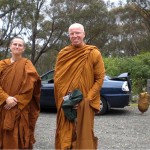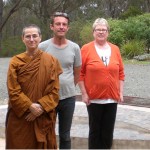Dear friends,
farewell and departure is always a large part of the life of any Buddhist monastic. We are not supposed to become attached to one particular place. In the Buddha’s time, it seems, the monks and nuns have been wandering for most time of the year, except for the period of three months every vassa.
In modern times this has changed quite a bit and monastics are more bound to their monasteries. None-the-less there is coming and going, people we share monastic life with, who have been or who are guests in Santi have left and will leave.
Our brother and friend Thanavuddho Bhikkhu left after 2 months and heeded on to Wat Buddha Dhamma to stay with Bhante Khemavaro for some time. It is rare to have a monk happily accepting female leadership. It certainly requires a lot of non-self :)
Our longterm lay-guest-man Sangvaro left this morning. He needs to work on his career now and goes to America for a while. It was very lovely and inspiring to see him work with himself to become a better person while he was here. And yes, the world is richer, as there is now one person definitely better than he was before. He changed to the better hopefully for good.
To see people changing like this through the power of the Dhamma and meditation, is the most beautiful thing to see, for one who teaches the Dhamma.
In less than two weeks Ayya Yeshe will also leave Santi. She has her place the Bodhicitta Foundation where she, with her work for the people and the Dhamma is needed in the slums of India. She brings light to a place in the world where there is darkness. She is strong, not many can do what she does for the people in the slums. She lives with them and shares with the people what you share with her.
Here are some pictures of our friends who took or will take leave soon.




In India, where our Buddhist religion originally appeared, there are very ancient traditions of due respect to any image of the Buddha, in any Buddhist Temple, or anywhere where it might be present. Observing the pictures that you present in Internet, I would like to bring to your attention, a few of these traditions of ours: : a) – the image must be alone on the altar; b) – no flowers must be put on the image itself or in the area where the image is; c) – no flower must be killed to be put in any altar of the Buddha; d) – only those flowers that naturally fall from the trees, or from any flower plant, and only those that are perfect, are allowed to be put on the area below the altar; e) -24 hours a day, every day of the year, lightened candles must be put on the area below, immediately around the platform where the image stands; the Buddha altar must never be surrounded by darkness; f) – you have the image of a black Buddha; this is a very serious thing; there should be a saffron mantle envolving this image, as if it alive would be.